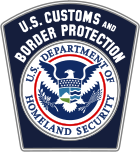U.S. Customs and Border Patrol
| U.S. Customs and Border Protection | |
|---|---|

Patch of CBP
|
|

Border Patrol Agent badge
|
|
| Agency overview | |
| Formed | March 1, 2003 |
| Preceding agencies |
|
| Employees | 62,450+ (2016) |
| Annual budget | $13.56 billion (2016) |
| Jurisdictional structure | |
| Federal agency | U.S. |
| Operations jurisdiction | U.S. |
| General nature | • Federal law enforcement |
| Headquarters |
Ronald Reagan Building Washington, D.C., U.S. |
| Federal Law Enforcement Sworn Officers | 45,741 |
| Agency executives |
|
| Parent agency | U.S. Department of Homeland Security |
| Website | |
| www.cbp.gov | |
United States Customs and Border Protection (CBP) is the largest federal law enforcement agency of the United States Department of Homeland Security. It is charged with regulating and facilitating international trade, collecting import duties, and enforcing U.S. regulations, including trade, customs, and immigration. CBP is one of the largest law enforcement agencies in the United States. It has a workforce of more than 45,600 sworn federal agents and officers. It has its headquarters in Washington, D.C.
CBP's Primary mission is to safeguard United States borders; thereby protecting the public from dangerous people and materials while enhancing U.S. global economic competitiveness by enabling legitimate trade and travel.
CBP has a workforce of over 58,000 employees, including officers and agents, agriculture specialists, aircraft pilots, trade specialists, mission support staff, and canine enforcement officers and agents.
There are 327 officially designated ports of entry and an additional 14 pre-clearance locations in Canada, Ireland, the Middle East, Bermuda and the Caribbean. CBP is also in charge of the Container Security Initiative, which identifies and inspects foreign cargo in its mother country before it is to be imported into the United States.
In addition the CBP has legal jurisdiction to conduct some activities up to 100 miles (161 km) inwards from any land or sea border. This can include operating interior checkpoints.
CBP assess all passengers flying into the U.S. for terrorist risk via the Joint Terrorism Task Force (JTTF) and systems such as Advance Passenger Information System (APIS), United States Visitor and Immigrant Status Indication Technology (US-VISIT), and the Student and Exchange Visitor System (SEVIS). CBP also works with the U.S. Food and Drug Administration to screen high-risk imported food shipments in order to prevent bio-terrorism and agro-terrorism.
...
Wikipedia
